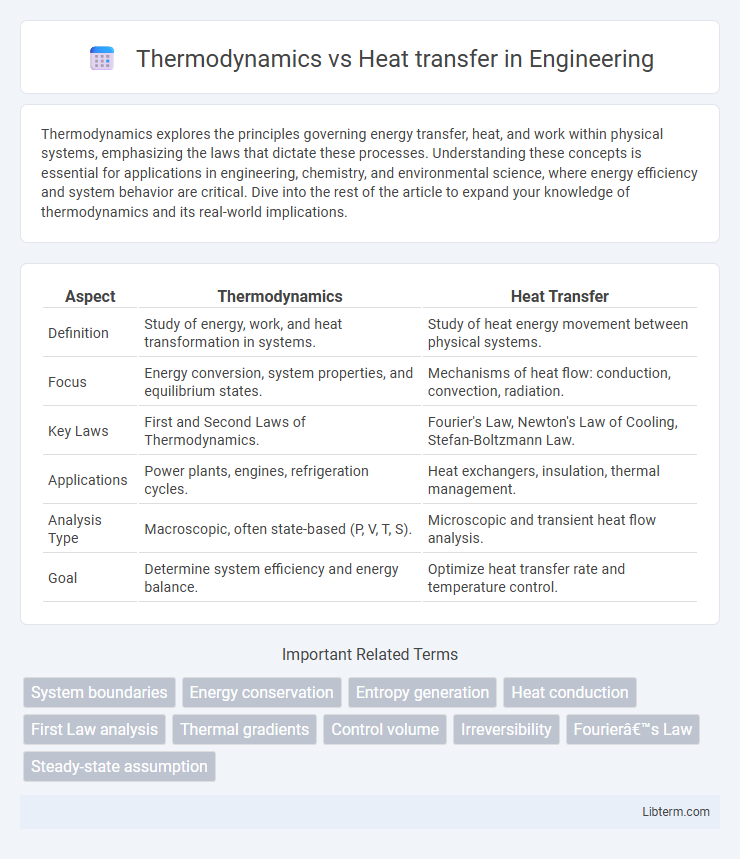Thermodynamics explores the principles governing energy transfer, heat, and work within physical systems, emphasizing the laws that dictate these processes. Understanding these concepts is essential for applications in engineering, chemistry, and environmental science, where energy efficiency and system behavior are critical. Dive into the rest of the article to expand your knowledge of thermodynamics and its real-world implications.
Table of Comparison
| Aspect | Thermodynamics | Heat Transfer |
|---|---|---|
| Definition | Study of energy, work, and heat transformation in systems. | Study of heat energy movement between physical systems. |
| Focus | Energy conversion, system properties, and equilibrium states. | Mechanisms of heat flow: conduction, convection, radiation. |
| Key Laws | First and Second Laws of Thermodynamics. | Fourier's Law, Newton's Law of Cooling, Stefan-Boltzmann Law. |
| Applications | Power plants, engines, refrigeration cycles. | Heat exchangers, insulation, thermal management. |
| Analysis Type | Macroscopic, often state-based (P, V, T, S). | Microscopic and transient heat flow analysis. |
| Goal | Determine system efficiency and energy balance. | Optimize heat transfer rate and temperature control. |
Introduction to Thermodynamics and Heat Transfer
Thermodynamics studies energy transformations and the principles governing systems at macroscopic scales, focusing on concepts such as temperature, internal energy, entropy, and the laws governing energy conservation and conversion. Heat transfer specifically examines the mechanisms by which thermal energy moves between systems or within a body, including conduction, convection, and radiation processes. Understanding the fundamentals of thermodynamics provides the framework for analyzing heat transfer phenomena in engineering and natural systems.
Fundamental Principles of Thermodynamics
Thermodynamics studies the fundamental principles governing energy, work, and heat interactions within systems, emphasizing laws such as the conservation of energy and entropy increase. Heat transfer specifically examines the mechanisms of heat flow--conduction, convection, and radiation--between physical bodies. Understanding thermodynamics provides the theoretical framework for predicting system behavior, while heat transfer quantifies energy exchange processes critical for engineering applications.
Core Concepts in Heat Transfer
Heat transfer focuses on the mechanisms of energy transfer through conduction, convection, and radiation, emphasizing temperature gradients and thermal properties of materials. Conduction involves energy transfer via molecular interactions within solids, while convection deals with fluid motion carrying heat, and radiation transfers energy through electromagnetic waves. The core concept revolves around quantifying heat flux, thermal resistance, and heat transfer coefficients to analyze and design thermal systems effectively.
Key Differences Between Thermodynamics and Heat Transfer
Thermodynamics studies energy transformations and the principles governing energy conservation, focusing on system states and properties like temperature, pressure, and entropy. Heat transfer specifically examines the mechanisms of heat movement--conduction, convection, and radiation--between different bodies or within materials. Thermodynamics provides the theoretical framework, while heat transfer applies these principles to analyze rate and mode of thermal energy flow.
Processes Analyzed by Thermodynamics
Thermodynamics analyzes processes involving energy transformations and the equilibrium states of systems, focusing on properties like temperature, pressure, volume, and internal energy. It governs the principles of energy conservation, entropy changes, and phase transitions, enabling the prediction of system behavior in cycles and reactions. This contrasts with heat transfer, which specifically studies the rate and mechanisms of thermal energy flow between systems or within materials.
Mechanisms of Heat Transfer: Conduction, Convection, and Radiation
Heat transfer mechanisms include conduction, convection, and radiation, each describing energy movement differently within thermodynamics. Conduction involves direct molecular collisions transmitting heat through solids, convection transfers heat via fluid motion driven by temperature-induced density variations, and radiation emits energy through electromagnetic waves without requiring a medium. Understanding these mechanisms is essential for optimizing thermal systems, improving energy efficiency, and designing insulation materials in engineering applications.
Applications of Thermodynamics in Engineering
Thermodynamics principles are fundamental in designing engines, refrigerators, and power plants, optimizing energy conversion and efficiency in engineering systems. Engineers apply laws of thermodynamics to analyze energy interactions, phase changes, and system equilibrium for improved mechanical and chemical processes. Heat transfer complements thermodynamics by focusing on temperature gradients and heat flow, essential in thermal management and material cooling applications.
Practical Uses of Heat Transfer Techniques
Heat transfer techniques are essential in numerous practical applications, including HVAC systems for climate control, industrial processes requiring precise temperature regulation, and electronics cooling to prevent overheating. Methods such as conduction, convection, and radiation optimize energy efficiency and maintain safety standards in manufacturing plants and power generation facilities. Advances in heat exchanger designs enhance performance in chemical processing and renewable energy systems, highlighting their critical role in energy management and sustainability.
Thermodynamics vs Heat Transfer in Real-World Systems
Thermodynamics analyzes energy transformations and system properties at equilibrium, while heat transfer focuses on the mechanisms of energy flow between systems in real-world applications. In engineering systems like power plants and HVAC units, thermodynamics defines system efficiency limits, whereas heat transfer dictates how effectively thermal energy moves through materials. Understanding both principles ensures optimal design and performance in industries relying on thermal management and energy conversion.
Conclusion: Complementary Roles in Energy Science
Thermodynamics provides the fundamental principles governing energy transformations and the direction of spontaneous processes, while heat transfer focuses on the mechanisms and rates of energy flow between systems. Both fields are essential in optimizing thermal systems, enabling efficient energy usage and management across engineering and natural processes. Their complementary roles drive advancements in energy science, from power generation to climate control technologies.
Thermodynamics Infographic

 libterm.com
libterm.com